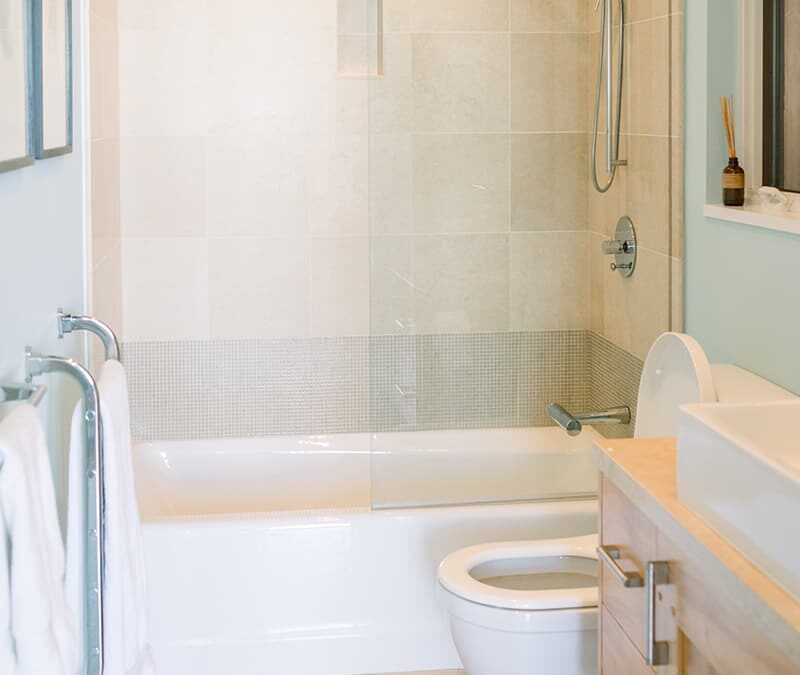A bathroom is more than just a functional space. It’s where we start and end our day, where we unwind with a hot shower or find moments of peace in a busy world. If your bathroom doesn’t feel like a relaxing retreat, it may be time for a change.
A renovation can enhance your comfort while increasing your home’s value. Use this ultimate checklist to create a bathroom you’ll love for years to come.
1. Identify What Needs to Change or Be Added
Start by assessing your current bathroom. Identify its shortcomings and determine what improvements are most important. Are you dealing with outdated fixtures or poor lighting? Is the layout cramped, or is there insufficient storage? Pinpointing these issues ensures your renovation focuses on what matters most.
Common challenges homeowners face include:
- Inefficient layouts or lack of space
- Not enough storage for toiletries
- Hard-to-clean or moisture-sensitive materials
- Poor lighting or no natural light
- Leaks, mold, or water damage
- An outdated look or aesthetic
- Ineffective ventilation or exhaust fans
Tip: Create a list of problems to address. Prioritize the changes that will have the most significant impact on your space.
2. Collect Inspiring Bathroom Design Ideas
This is the fun part—finding inspiration! Look for bathroom design ideas online. Platforms like Pinterest, Instagram, and Houzz are excellent resources. Save images that resonate with you and reflect the style you want.
Focus on elements like:
- Tile design, size, and color
- Flooring materials and patterns
- Countertops and vanity styles
- Paint colors or wallpaper patterns
- Fixtures like sinks, faucets, and shower doors
- Lighting styles, including natural and artificial options
- Decorative accents, such as mirrors and towel racks
Tip: Visit home improvement stores or showrooms to see materials in person. Bring home samples to see how they look in your bathroom’s lighting.
3. Set a Realistic Budget
Bathroom renovations can range from minor updates to luxury makeovers. Start by setting a clear budget. This will guide your decisions and help avoid unexpected expenses. Consider what features are essential and where you’re willing to splurge.
Costs to consider include:
- Moving plumbing fixtures or changing layouts
- Upgrading old bathrooms to meet modern codes
- Installing high-end features like heated floors or rain showers
- Choosing durable, high-quality materials
Tip: Allocate 10-15% of your budget for unexpected costs. This will ensure that you’re prepared for surprises during the renovation process.
4. Decide on Functionality and Layout
While aesthetics are exciting, functionality is key. Think about how the space will be used. Is the current layout efficient? Does it meet your household’s needs?
Ask yourself these questions:
- Is the vanity the right size for your daily routine?
- Does the shower or bathtub suit your family’s preferences?
- Is there enough ventilation to prevent moisture buildup?
- Are outlets placed where you need them most?
Tip: If you’re unsure about layouts, consult a professional. Designers can help you optimize the space for style and practicality.
5. Choose the Right Materials
Bathrooms are heavily used and constantly exposed to moisture. Therefore, it is essential to select durable, water-resistant materials. Focus on surfaces that are easy to clean and long-lasting.
Best materials for bathrooms:
- Porcelain or ceramic tiles for floors and walls
- Quartz or granite countertops
- Mold-resistant paint or wallpaper
- Stainless steel or brass fixtures
Tip: Look for slip-resistant flooring to ensure safety. This is especially important if you have children or older adults in your home.
6. Hire a Skilled Professional
A bathroom remodel is not the time for DIY experiments. Professional contractors bring expertise and experience. They ensure the work meets safety standards and local codes. This saves you time, stress, and potential repair costs later on.
How to find the right contractor:
- Verify their credentials and licenses
- Read reviews from trusted platforms
- Ask for references from previous clients
- Request a clear contract and project timeline
Tip: Ask about warranties on the work. A good contractor will stand behind their services.
7. Plan for the Future
Your bathroom should meet your current needs and adapt to future ones. Consider features that offer long-term benefits, such as energy-efficient fixtures or designs that support aging in place.
Future-ready bathroom ideas:
- Walk-in showers with no thresholds
- Grab bars that match the aesthetic of the bathroom
- Energy-efficient lighting and water-saving fixtures
Tip: Invest in features that lower utility bills. Eco-friendly options save money and reduce your environmental impact.
A bathroom renovation is a big project, but it’s also rewarding. With careful planning and the right approach, you can create a space that’s both beautiful and functional. Follow this checklist to stay on track and make your dream bathroom a reality.
Ready to get started? Contact Legacy Homes Cimala for expert luxury bathroom remodel service and home custom remodeling.
